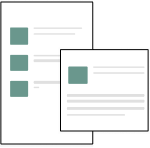Hire the Best Communications Brief Talent for Your Project
What is a communications brief? A communications brief is a document that sums up a project’s mission, goals, challenges, messaging, or any other key detail to pave the way for the creative process. A brief is presented to a client or company before the start of the project and becomes the blueprint for creative production.
Our Talent has worked with
How it Works
Post your project details
Tell us what you need, when you need it, and the type of skill set you are looking to hire. List your project on our platform for talent to see.

Choose from our top Talent
Browse from hundreds of vetted experts, and invite talent to pitch on the project. Browse through their skills sets, qualifications, and utilize the chat box for real time communication.

Collaboration made easy
Once the client identifies which profile(s) they wish to work with, the client is able to invite the talent to the project, with both client and talent agreeing on deliverables, price and timeline of the engagement.

Receive proposals and hire talent
Congratulations! You and your freelancer are ready to get to work. Payment and contract integration all happen on the platform automatically for you.

The brief serves as a detailed road map that allows creative and media ad professionals to turn the strategy into engaging creative messaging. A successful communications brief should include the objective, the target audience, the proposition, support, tonality, moments of receptivity, and collaboration.
How to write the perfect brief:
In order to write the perfect brief, you need to be perfectly clear on your company’s goals and intentions. This single piece of paper serves as the blueprint, or roadmap, for the rest of the team to take your idea forward. Your communications brief must be specific, detailed, and easily receptive to the client, the strategy teams, and the creatives. Listed below are sections your successful communications brief must include:
Objective: The objective is the statement of what needs to be accomplished. This must include specific, measurable goals, and a timetable to achieve them.
Target Audience: The target audience segment is a detailed statement of demographics, psychographics, and deep-seated emotions that are important to understanding who the core target is and why the message will be relevant to them. This part of the brief needs to tell creatives the “insight” you have into the target audience, and who is the intended target for advertising.
Proposition: The proposition is a single sentence of what the advertising will actually attempt to communicate. It serves as the true compelling promise and the message for the specific ad, or campaign, for which the communications brief has been written. The proposition must be single-minded and carries one message.
Support: The support gives consumers reasons to believe that the benefit you are highlighting in your ad is actually true. The support requires proof that makes your brand’s image unique in the mind of the consumers.
Tonality: The tonality creates the personality of the advertising. Think about how the ad should feel to fit its brand and message and what consumers will feel when they hear your brand. The tonality section is often short, with just a few adjectives describing the target tonality.
Moments of receptivity: The moments of receptivity is when people would see and absorb your message the best. In this section, it is important to identify best times, places, and/or specific mindsets that are appropriate for the target to “hear” our message. This section answers the “where” and “when” for optimal viewing times.
Collaboration: Collaboration is the step wheremedia and creative people need to be consulted during the development of the brief to contextualize each other. The blueprint for the creative map is underway.














